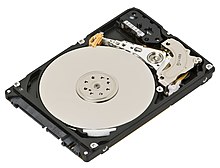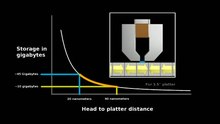hard disk drive
hard disk drive (hdd)

Internals of a 2.5-inch SATA hard disk drive
| |
| Date invented | 24 December 1954[a] |
|---|---|
| Invented by | IBM team led by Rey Johnson |
A hard disk drive (HDD), hard disk, hard drive or fixed disk[b] is an electromechanical data storage device that uses magnetic storage to store and retrieve digital information using one or more rigid rapidly rotating disks (platters) coated with magnetic material. The platters are paired with magnetic heads, usually arranged on a moving actuator arm, which read and write data to the platter surfaces.[2] Data is accessed in a random-access manner, meaning that individual blocks of data can be stored or retrieved in any order and not only sequentially. HDDs are a type of non-volatile storage, retaining stored data even when powered off.[3][4][5]
Introduced by IBM in 1956,[6] HDDs became the dominant secondary storage device for general-purpose computers by the early 1960s. Continuously improved, HDDs have maintained this position into the modern era of servers and personal computers. More than 200 companies have produced HDDs historically, though after extensive industry consolidation most units are manufactured by Seagate, Toshiba, and Western Digital. HDDs dominate the volume of storage produced (exabytes per year) for servers. Though production is growing slowly, sales revenues and unit shipments are declining because solid-state drives (SSDs) have higher data-transfer rates, higher areal storage density, better reliability,[7] and much lower latency and access times.[8][9][10][11]
The revenues for SSDs, most of which use NAND, slightly exceed those for HDDs.[12] Though SSDs have nearly 10 times higher cost per bit, they are replacing HDDs where speed, power consumption, small size, and durability are important.[10][11]
The primary characteristics of an HDD are its capacity and performance. Capacity is specified in unit prefixes corresponding to powers of 1000: a 1-terabyte (TB) drive has a capacity of 1,000 gigabytes (GB; where 1 gigabyte = 1 billion bytes). Typically, some of an HDD's capacity is unavailable to the user because it is used by the file system and the computer operating system, and possibly inbuilt redundancy for error correction and recovery. Performance is specified by the time required to move the heads to a track or cylinder (average access time) plus the time it takes for the desired sector to move under the head (average latency, which is a function of the physical rotational speed in revolutions per minute), and finally the speed at which the data is transmitted (data rate).
The two most common form factors for modern HDDs are 3.5-inch, for desktop computers, and 2.5-inch, primarily for laptops. HDDs are connected to systems by standard interface cables such as PATA (Parallel ATA), SATA (Serial ATA), USB or SAS (Serial Attached SCSI) cables.
hard disk drive
![hard disk drive]() Reviewed by moviebuzz
on
August 03, 2018
Rating:
Reviewed by moviebuzz
on
August 03, 2018
Rating:







No comments: